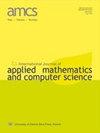天线选择系统在干扰有限的不同复合衰落环境下的M2M无线链路性能分析
IF 1.2
4区 计算机科学
Q3 AUTOMATION & CONTROL SYSTEMS
International Journal of Applied Mathematics and Computer Science
Pub Date : 2022-12-01
DOI:10.34768/amcs-2022-0040
引用次数: 0
摘要
摘要本文研究了在干扰受限、不同复合衰落环境下,目标移动节点(DMN)采用双天线选择(AS)系统的直接移动到移动(M2M)通信。特别是,我们将双支路AS系统输入端的不同干扰限制信号建模为(i)第一个支路的两个Nakagami-m (N)随机变量(RVs)的比率,以及(ii)第二个支路的两个Rice RVs的比率,以分别考虑非视距(NLOS)和视距(LOS)通信。此外,为了考虑阴影的影响,我们假设DMN输出的期望信号和干扰信号的功率是可变的。对于所提出的模型,我们导出了概率密度函数、累积分布函数、中断概率和平均水平交叉率。对所考虑的所有统计度量进行了统计结果评估,并以图形形式呈现,以便深入了解所需信号的复合衰落严重程度和LOS因素以及干扰对系统性能的影响。本文章由计算机程序翻译,如有差异,请以英文原文为准。
Analytical Performance Analysis of the M2M Wireless Link with an Antenna Selection System Over Interference Limited Dissimilar Composite Fading Environments
Abstract This paper considers direct mobile-to-mobile (M2M) communications with a dual antenna selection (AS) system at a destination mobile node (DMN) in interference limited, dissimilar composite fading environments. In particular, we model dissimilar interference limited signals at the inputs of the dual branch AS system as (i) the ratio of two Nakagami-m (N) random variables (RVs) at the first branch and (ii) the ratio of two Rice RVs at the second branch, in order to account for non line-of-sight (NLOS) and line-of-sight (LOS) communications, respectively. Moreover, we assume variable powers of the desired as well as interference signals at the output of the DMN in order to account for the impact of shadowing. For the proposed model, we derive probability density functions, cumulative distribution functions, outage probabilities and average level crossing rates. The derived statistical results are evaluated for all the statistical measures considered and are graphically presented in order to provide insight into the impact of composite fading severities and LOS factors for the desired signal, as well as for the interference, on the system performances.
求助全文
通过发布文献求助,成功后即可免费获取论文全文。
去求助
来源期刊
CiteScore
4.10
自引率
21.10%
发文量
0
审稿时长
4.2 months
期刊介绍:
The International Journal of Applied Mathematics and Computer Science is a quarterly published in Poland since 1991 by the University of Zielona Góra in partnership with De Gruyter Poland (Sciendo) and Lubuskie Scientific Society, under the auspices of the Committee on Automatic Control and Robotics of the Polish Academy of Sciences.
The journal strives to meet the demand for the presentation of interdisciplinary research in various fields related to control theory, applied mathematics, scientific computing and computer science. In particular, it publishes high quality original research results in the following areas:
-modern control theory and practice-
artificial intelligence methods and their applications-
applied mathematics and mathematical optimisation techniques-
mathematical methods in engineering, computer science, and biology.

 求助内容:
求助内容: 应助结果提醒方式:
应助结果提醒方式:


